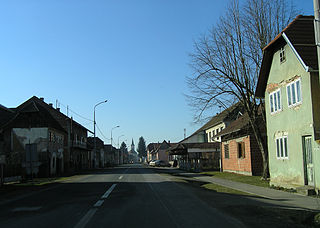
Sisak is a city in central Croatia, spanning the confluence of the Kupa, Sava and Odra rivers, 57 km (35 mi) southeast of the Croatian capital Zagreb, and is usually considered to be where the Posavina begins, with an elevation of 99 m. The city's total population in 2021 was 40,185 of which 27,886 live in the urban settlement (naselje).

Sisak-Moslavina County is a Croatian county in eastern Central Croatia and southwestern Slavonia. It is named after the city of Sisak and the region Moslavina just across the river Sava. According to 2021 census it is inhabited by 141,000 people.

Brod-Posavina County is the southern Slavonian county in Croatia. Its center is the city of Slavonski Brod and it spreads along the left bank of the Sava river, hence the name Posavina. Other notable towns include Nova Gradiška.
Brestovac is a village and a municipality in eastern Croatia, located west of Požega.

Jasenovac is a village and a municipality in Croatia, in the southern part of the Sisak-Moslavina County at the confluence of the river Una into Sava. In Croatian and Serbian word "jasen" means ash tree and the name Jasenovac means "ashen, or made of ash tree". During World War II, it was the site of the Jasenovac concentration camp.

Topusko is a municipality in Sisak-Moslavina County, Croatia. Topusko is an underdeveloped municipality which is statistically classified as the First Category Area of Special State Concern by the Government of Croatia.

Grubišno Polje is a town in Bjelovar-Bilogora County, Croatia.

Hrvatska Dubica is a village and a municipality in central Croatia in the Sisak-Moslavina County. It is located on the northern bank of the river Una, east of Hrvatska Kostajnica and southwest of Jasenovac and Novska. The town of Kozarska Dubica lies to the south of the municipality, in Bosnia and Herzegovina. Hrvatska Dubica is underdeveloped municipality which is statistically classified as the First Category Area of Special State Concern by the Government of Croatia.

Donji Kukuruzari is a village and a municipality in Croatia in the Sisak-Moslavina County. Donji Kukuruzari is underdeveloped municipality which is statistically classified as the First Category Area of Special State Concern by the Government of Croatia.

Majur is a settlement and a municipality in central Croatia in the Sisak-Moslavina County. It has a population of 1,185, 70.04% of whom are Croats and 27.26% are ethnic Serbs.
Popovača is a town in Croatia in the Moslavina geographical region. Administratively it is part of the Sisak-Moslavina County.
Podravska Moslavina is a village and a municipality in Osijek-Baranja County, Croatia. There are 1,202 inhabitants in the municipality.
Brđani Cesta is a village in Croatia, in the municipality of Sunja, Sisak-Moslavina County. It is connected by the D224 highway.
Mala Gradusa is a village in central Croatia, in the municipality of Sunja, Sisak-Moslavina County. It is located in the Banija region.
Bestrma is a village in central Croatia, in the municipality of Sunja, Sisak-Moslavina County. It is located in the Banija region.
Crkveni Bok is a village in central Croatia, in the municipality of Sunja, Sisak-Moslavina County. It is located in the Banija region, in the fertile plains on the right bank of the Sava river, to the east of the town of Sunja and some 20 km north-west of village of Jasenovac.
Ivanjski Bok is a village in central Croatia, in the municipality of Sunja, Sisak-Moslavina County. It is located in the Banija region, in the fertile plains on the right bank of the Sava river, to the east of the town of Sunja and some 20 km north-west of village of Jasenovac.
Strmen is a village in central Croatia, in the municipality of Sunja, Sisak-Moslavina County. It is located in the Banija region.
Velika Gradusa is a village in central Croatia, in the municipality of Sunja, Sisak-Moslavina County. It is located in the Banija region.
Brđani Kosa is a village in Croatia, in the municipality of Sunja, Sisak-Moslavina County. It is connected by the D224 highway.













